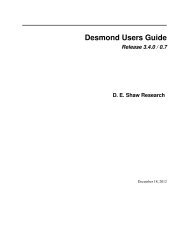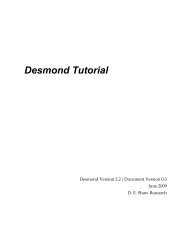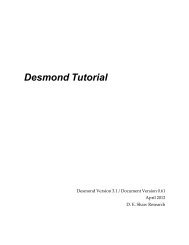Desmond Tutorial
Desmond Tutorial - DE Shaw Research
Desmond Tutorial - DE Shaw Research
- No tags were found...
Create successful ePaper yourself
Turn your PDF publications into a flip-book with our unique Google optimized e-Paper software.
<strong>Desmond</strong> <strong>Tutorial</strong><br />
Finishing Preparations for <strong>Desmond</strong> Simulation<br />
field provides the dihedral parameters for the same residues. The force field components<br />
should be disjoint so there is no conflict with the parameters that are assigned to each<br />
component.<br />
You may also use multiple force fields when parameters assigned to a particular residue<br />
by one force field override parameters assigned by another force field. This situation is<br />
similar to combining force fields; residues in the chemical system match templates in<br />
more than one of the specified force fields and all matching force fields are applied.<br />
However, in this case two or more force fields provide parameters for the same term; for<br />
example, two force fields provide parameters for the angle between atoms 1, 2, and 3<br />
causing a conflict. The conflict is resolved by allowing the first force field (that matches<br />
the residue) to take precedence. The order is the order in which the force fields were<br />
specified on the command line.<br />
In all multiple force field assignment cases, Viparr prints an error message and aborts if a<br />
bond exists between two residues that are not matched by the same force field.<br />
The selected force fields should also have consistent van der Waals combining rules.<br />
Otherwise, Viparr will abort with an error message.<br />
Viparr will print the following warning and error messages when matching residues to<br />
templates:<br />
• If any residue matches more than one template in a force field, then Viparr exits with<br />
an error. (No Viparr force field should contain identical templates.)<br />
• If any residue name is matched to a force field template with a different name, a<br />
message is printed. A maximum of 5 messages are printed per residue‐template<br />
name pair.<br />
• Viparr will check that all residues are matched by one of the selected force fields. If<br />
there are any unmatched residues, Viparr will print all unmatched residues and exit<br />
with an error. A maximum of 5 messages are printed per unmatched residue name.<br />
• If any residue is matched by more than one of the selected force fields, Viparr will<br />
print a warning message. The user should be cautious and be responsible for any<br />
intended use of multiple force fields with multiple matches.<br />
Besides the -f option, there are two more basic options. The -c option allows the user to<br />
assign parameters for a particular structure (CT block) in the input .cms file and the -n<br />
option provides a means to include a user‐defined comment in the output .cms file for<br />
annotation purposes.<br />
Viparr also supports user‐defined, special force fields (the -d, -m, and -p options), but<br />
that is beyond the scope of this tutorial. Please refer to the <strong>Desmond</strong> User Guide for information.<br />
Specifying <strong>Desmond</strong> Simulation Parameters<br />
Before it can perform simulations, <strong>Desmond</strong> needs certain simulation parameters to be<br />
set. These parameters can be set in two ways:<br />
• Using the Run <strong>Desmond</strong> facility in Maestro.<br />
• Editing the <strong>Desmond</strong> conguration file directly.<br />
The following sections provide more details on each option.<br />
60 D. E. Shaw Research September 2008






